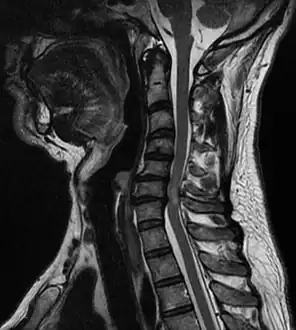Spinal cord compression
| Spinal cord compression | |
|---|---|
 | |
| A tumour causing spinal cord compression | |
| Specialty | Neurosurgery |
Spinal cord compression develops when the spinal cord is compressed by bone fragments from a vertebral fracture, a tumor, abscess, ruptured intervertebral disc or other lesion. It is regarded as a medical emergency independent of its cause, and requires swift diagnosis and treatment to prevent long-term disability due to irreversible spinal cord injury.
Signs and symptoms
Symptoms suggestive of cord compression are back pain, a dermatome of increased sensation, paralysis of limbs below the level of compression, decreased sensation below the level of compression, urinary and fecal incontinence and/or urinary retention. Lhermitte's sign (intermittent shooting electrical sensation) and hyperreflexia may be present.
Cause
In terms of the cause of spinal cord compression we find the following:[1]
- Degenerative spondylosis with myelopathy
- Metastatic disease of the spine
- Primary spinal cord malignancy
- Spinal epidural abscess
- Iatrogenic spinal epidural hematoma
Diagnosis
Diagnosis is by X-rays but preferably magnetic resonance imaging (MRI) of the whole spine.[2] The most common causes of cord compression are tumors, but abscesses and granulomas (e.g. in tuberculosis) are equally capable of producing the syndrome. Tumors that commonly cause cord compression are lung cancer (non-small cell type), breast cancer, prostate cancer, renal cell carcinoma, thyroid cancer, lymphoma and multiple myeloma.
_(1).png.webp) Image indicates C5–C6 with severe spinal cord compression (and large disc herniation at C4–C5 )
Image indicates C5–C6 with severe spinal cord compression (and large disc herniation at C4–C5 ) Compressive myelopathy at the C6-C7 level due to disc protrussion
Compressive myelopathy at the C6-C7 level due to disc protrussion
Treatment
Dexamethasone (a potent glucocorticoid) in doses of 16 mg/day may reduce edema around the lesion and protect the cord from injury. It may be given orally or intravenously for this indication.
Surgery is indicated in localised compression as long as there is some hope of regaining function. It is also occasionally indicated in patients with little hope of regaining function but with uncontrolled pain. Postoperative radiation is delivered within 2–3 weeks of surgical decompression. Emergency radiation therapy (usually 20 grays in 5 fractions, 30 grays in 10 fractions or 8 grays in 1 fraction) is the mainstay of treatment for malignant spinal cord compression. It is very effective as pain control and local disease control. Some tumours are highly sensitive to chemotherapy (e.g. lymphomas, small-cell lung cancer) and may be treated with chemotherapy alone.
Once complete paralysis has been present for more than about 24 hours before treatment, the chances of useful recovery are greatly diminished, although slow recovery, sometimes months after radiotherapy, is well recognised.
Prognosis
The median survival of patients with metastatic spinal cord compression is about 12 weeks, reflecting the generally advanced nature of the underlying malignant disease.
References
- ↑ Singleton, Jennifer M.; Hefner, Matthew (2022). "Spinal Cord Compression". StatPearls. StatPearls Publishing. Archived from the original on 5 August 2022. Retrieved 11 September 2022.
- ↑ Anthony S. Fauci; Eugene Braunwald; Dennis L. Kasper; Stephen L. Hauser; Dan L. Longo; J. Larry Jameson; Joseph Loscalzo (19 March 2009). Harrison's Manual of Medicine. McGraw Hill Professional. pp. 94–. ISBN 978-0-07-147743-7. Archived from the original on 24 May 2021. Retrieved 17 April 2010.
- Loblaw DA, Perry J, Chambers A, Laperriere NJ (March 2005). "Systematic review of the diagnosis and management of malignant extradural spinal cord compression: the Cancer Care Ontario Practice Guidelines Initiative's Neuro-Oncology Disease Site Group". J. Clin. Oncol. 23 (9): 2028–37. doi:10.1200/JCO.2005.00.067. PMID 15774794.
External links
| Classification |
|---|